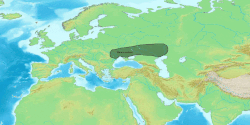Paeonian language
| Part of a series on |
| Indo-European topics |
|---|
 |
Paeonian, sometimes spelled Paionian, is a poorly attested, extinct language spoken by the ancient Paeonians until late antiquity.
Paeonia was located to the north of Macedon, south of Dardania, west of Thrace, and east of the southernmost Illyrians.
Classification
Classical sources usually considered the Paeonians distinct from the rest of the Paleo-Balkan people, comprising their own ethnicity and language. It is considered a Paleo-Balkan language but this is only a geographical grouping, not a genealogical one. Modern linguists are uncertain as to the classification of Paeonian, due to the extreme scarcity of surviving materials in the language, with numerous hypotheses having been published:
- Wilhelm Tomaschek and Paul Kretschmer have put forward an “Illyrian” hypothesis (i.e a part of the linguistic complex of the ancient north-western Balkans) which, according to Radoslav Katičić, seems to be the prevailing opinion.
- Dimitar Dečev and Susan Wise Bauer proposed a Thracian hypothesis.
- Francesco Villari proposed a Thraco-Illyrian hypothesis.
- Karl Beloch, Ioannis Svoronos and Irwin L. Merker consider Paeonian an ancient Greek dialect (or a lost Indo-European language very closely related to Greek, i.e Hellenic) with a great deal of Thracian and Illyrian influence.
- Vladimir I. Georgiev suggested a Phrygian affiliation.
- Athenaeus seems to have connected the Paeonian language to the Mysian language, which was possibly a member of the Anatolian languages, or of the Armeno-Phrygian languages.
- Radoslav Katičić has said that “we know so little about their language that any linguistic affiliation seems meaningless”.
Paeonian vocabulary
Several Paeonian words are known from classical sources:
- monapos, monaipos, the European bison
- tilôn, a species of fish once found in Lake Prasias
- paprax, a species of fish once found in Lake Prasias. Paprakas, masc. acc. pl.
A number of anthroponyms (some known only from Paeonian coinage) are attested: Agis (Άγις), Patraos (Πατράος), Lycpeios (Λύκπειος), Audoleon (Αυδολέων), Eupolemos (Εὐπόλεμος), Ariston (Αρίστων), etc. In addition several toponyms (Bylazora (Βυλαζώρα), Astibos (Άστιβος) and a few theonyms Dryalus (Δρύαλος), Dyalos (Δύαλος), the Paeonian Dionysus, as well as the following:
- Pontos, effluent of the Strumica River, perhaps from *ponktos, "boggy" (cf. German feucht, "wet", Middle Irish éicne "salmon", Sanskrit pánka "mud, mire", Greek pontos "passage", "way");
- Idomenae (Ιδομένη) (nowadays near Gevgelija), name of a city (cf. Greek Idomeneus, proper name in Homer; "Ida", mountain in Crete);
- Stoboi (today Gradsko), name of a city, from *stob(h) (cf. Old Prussian stabis "rock", Old Church Slavonic stoboru, "pillar", Old English stapol, "post", Ancient Greek stobos, "scolding, bad language");
- Dysoron (Δύσορον and Δύσωρον, nowadays Dysoro, Δύσορο), name of a mountain, from "dys-", "bad" (cf. Greek dyskolos "difficult", and "oros" Greek oros, "mountain");
- Agrianes, name of a tribe, possibly from *agro- "field" (cf. Lat. ager, Grc. ἀγρός agros, Eng. acre) with cognates in the Greek tribe of Agraioi who lived in Aetolia, and the name of the month Agrianos which is found throughout the Dorian and Aeolian worlds.
References
Further reading
- Francisco Villar. Gli Indoeuropei e le origini dell'Europa. Il Mulino, 1997.ISBN 88-15-05708-0
- Kevin Hodges (November 2010). "Fluent in 60 Seconds: Learning a new language is a breeze—as long as it's Paionian". Smithsonian magazine. Archived from the original on 2012-06-25. Retrieved 2013-05-11.